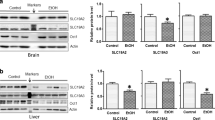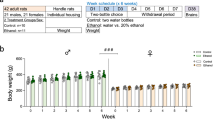Abstract
One common characteristic of neurodegenerative diseases is dysregulation of iron, usually with observed increases in its concentration in various regions. Heavy alcohol consumption is believed to contribute to such iron dysregulation in the brain with accompanying dementia. To examine this effect and related genetic-based individual differences in an animal model, we subjected female mice from 12 BXD recombinant inbred strains to 16 weeks of alcohol consumption using the drinking in the dark (DID) method. Daily consumption was recorded and at the end of 16 weeks hippocampus tissues harvested. Concentrations of iron, copper and zinc were measured using X-ray fluorescence technology. The results showed that, DID increased iron overall across all strains, ranging from 3 to 68%. Copper and Zinc both decreased, ranging from 0.4–42 and 5–35% respectively. Analysis of variance revealed significant strain by treatment interactions for all three metals. Additionally, in the DID group, we observed strain differences in reduction of hippocampus mass. These findings are particularly interesting to us because high alcohol consumption in humans has been associated with neurodegeneration and dementia related to disruption of iron regulation. The findings of alcohol consumption associated decreases in copper and zinc are novel. The role of copper regulation and neurological function related to alcohol consumption is as yet largely unexplored. The role of zinc is better known as a neuromodulator in the hippocampus and appears to be protective against neurological damage. It would seem then, that the alcohol-related decrease in zinc in the hippocampus would be of concern and warrants further study.



Similar content being viewed by others
Data availability
Summary data are available at www.GeneNetwork.org. Raw data available upon request.
References
Allen RP, Earley CJ (2007) The role of iron in restless legs syndrome. Mov Disord 22(Suppl 18):S440–S448. https://doi.org/10.1002/mds.21607. Erratum in: Mov Disord (2008) 23:1200–1202
Anderson JG, Fordahl SC, Cooney PT, Weaver TL, Colyer CL, Erikson KM (2009) Extracellular norepinephrine, norepinephrine receptor and transporter protein and mRNA levels are differentially altered in the developing rat brain due to dietary iron deficiency and manganese exposure. Brain Res 1281:1–14
Ashbrook DG, Arends D, Prins P, Mulligan MK, Roy S, Williams EG, Lutz CM, Valenzuela A, Bohl CJ, Ingels JF, McCarty MS, Centeno AG, Hager R, Auwerx J, Lu L, Williams RW (2021) A platform for experimental precision medicine: the extended BXD mouse family. Cell Syst 12(3):235-247.e9. https://doi.org/10.1016/j.cels.2020.12.002
Beard JL (2008) Why iron deficiency is important in infant development. J Nutr 138:2534–2536
Beard JL, Erikson KM, Jones BC (2002) Neurobehavioral analysis of developmental iron deficiency in rats. Behav Brain Res 134:517–524
Cristóvão JS, Santos R, Gomes CM (2016) Metals and neuronal metal binding proteins implicated in Alzheimer’s disease. Oxid Med Cell Longev. https://doi.org/10.1155/2016/9812178
Deibel MA, Ehmann WD, Markesbery WR (1996) Copper, iron, and zinc imbalances in severely degenerated brain regions in Alzheimer’s disease: possible relation to oxidative stress. J Neurol Sci 143:137–142. https://doi.org/10.1016/S0022-510X(96)00203-1
Erikson KM, Jones BC, Beard JL (2000) Iron deficiency alters dopamine transporter functioning in rat striatum. J Nutr 130:2831–2837
Erikson KM, Jones BC, Hess EJ, Beard JL (2001) Altered functioning of dopamine D1 and D2 receptors in brains of iron deficient rats. Pharmacol Biochem Behav 69:409–418
Filipe PM, Fernandes AC (1995) Manso CF (1995) Effects of zinc on copper-induced and spontaneous lipid peroxidation. Biol Trace Elem Res 47:51–56. https://doi.org/10.1007/BF02790100
Jellen LC, Unger EL, Lu L, Williams RW, Rousseau S, Wang X, Earley CJ, Allen RP, Miles MF, Jones BC (2012) Systems genetic analysis of the effects of iron deficiency in mouse brain. Neurogenetics 13:147–157
Kell DB (2009) Iron behaving badly: inappropriate iron chelation as a major contributor to the aetiology of vascular and other progressive inflammatory and degenerative diseases. BMC Med Genomics 8(2):2. https://doi.org/10.1186/1755-8794-2-2
Lan J, Jiang DH (1997) Excessive iron accumulation in the brain: a possible potential risk of neurodegeneration in Parkinson’s disease. J Neural Transm 104:649–660
Listabarth S, König D, Vyssoki B, Hametner S (2020) Does thiamine protect the brain from iron overload and alcohol-related dementia? Alzheimer’s Dement 16:1591–1595. https://doi.org/10.1002/alz.12146
Lozoff B (2011) Early iron deficiency has brain and behavior effects consistent with dopaminergic dysfunction. J Nutr 141:740S-746S
Malavolta M, Piacenza F, Basso A, Giacconi R, Costarelli L, Mocchegiani E (2015) Serum copper to zinc ratio: relationship with aging and health status. Mech Ageing Dev. https://doi.org/10.1016/j.mad.2015.01.004
Martin WR, Wieler M, Gee M (2008) Midbrain iron content in early Parkinson’s disease: a potential biomarker of disease status. Neurology 70:1411–1417
Mezzaroba L, Alfieri DF, Colado Simão AN, Vissoci Reiche EM (2019) The role of zinc, copper, manganese, and iron in neurodegenerative diseases. Neurotoxicology 74:230–241. https://doi.org/10.1016/j.neuro.2019.07.007
Mulligan MK, Zhao W, Dickerson M, Arends D, Prins P, Cavigelli SA, Terenina E, Mormede P, Lu L, Jones BC (2018) Genetic contribution to initial and progressive alcohol intake among recombinant inbred strains of mice. Front Genet 9:370. https://doi.org/10.3389/fgene.2018.00370
Mulligan MK, Lu L, Cavigelli SA, Mormède P, Terenina E, Zhao W, Williams RW, Jones BC (2019) Impact of genetic variation on stress-related ethanol consumption. Alcohol Clin Exp Res 43:1391–1402. https://doi.org/10.1111/acer.14073
Osredkar J (2011) Copper and zinc, biological role and significance of copper/zinc imbalance. J Clin Toxicol. https://doi.org/10.4172/2161-0495.S3-001
Rhodes SL, Ritz B (2008) Genetics of iron regulation and the possible role of iron in Parkinson’s disease. Neurobiol Dis 32:183–195
Rhodes JS, Best K, Belknap JK, Finn DA (2005) Crabbe JC (2005) Evaluation of a simple model of ethanol drinking to intoxication in C57BL/6J mice. Physiol Behav 84:53–63. https://doi.org/10.1016/j.physbeh.2004.10.007
Sensi SL, Granzotto A, Siotto M, Squitti R (2018) Copper and zinc dysregulation in Alzheimer’s disease. Trends Pharmacol Sci 39:1049–1063. https://doi.org/10.1016/j.tips.2018.10.001
Spotorno N, Acosta-Cabronero J, Stomrud E, Lampinen B, Strandberg OT, van Westen D, Hansson O (2020) Relationship between cortical iron and tau aggregation in Alzheimer’s disease. Brain 143:1341–1349. https://doi.org/10.1093/brain/awaa089
Takeda A, Tamano H, Nishio R, Murakami T (2016) Behavioral abnormality induced by enhanced hypothalamo-pituitary-adrenocortical axis activity under dietary zinc deficiency and its usefulness as a model. Int J Mol Sci 17:1149. https://doi.org/10.3390/ijms17071149
Tamano H, Takeda A (2019) Age-dependent modification of intracellular Zn2+ buffering in the hippocampus and its impact. Biol Pharm Bull 42:1070–1075. https://doi.org/10.1248/bpb.b18-00631
Wahlsten D (1990) Insensitivity of the analysis of variance to heredity–environment interaction. Behav Brain Sci 13:109–120. https://doi.org/10.1017/S140525X00077797
Yin L, Unger EL, Jellen LC, Earley CJ, Allen RP, Tomaszewicz A, Fleet JC, Jones BC (2012) Systems genetics analysis of multivariate response to iron deficiency in mice. Am J Physiol Regul Integr Comp Physiol 302:R1282–R1296
Funding
This study was supported in part by USPHS Grant R01AA021951.
Author information
Authors and Affiliations
Contributions
BCJ and MKM; designed study and wrote main text: KME, LL, and RWW: edited text: WZ, DZ and CT-R performed DID, conducted the metals analysis, ran statistical analyses and produced graphs.
Corresponding author
Ethics declarations
Conflict of interest
The authors declare no conflicts of interest.
Ethical approval
All procedures using live mice were approved by the UTHSC Institutional Animal Care and Use Committee.
Additional information
Publisher's Note
Springer Nature remains neutral with regard to jurisdictional claims in published maps and institutional affiliations.
Rights and permissions
About this article
Cite this article
Jones, B.C., Erikson, K.M., Mulligan, M.K. et al. Genetic differences in ethanol consumption: effects on iron, copper, and zinc regulation in mouse hippocampus. Biometals 34, 1059–1066 (2021). https://doi.org/10.1007/s10534-021-00327-8
Received:
Accepted:
Published:
Issue Date:
DOI: https://doi.org/10.1007/s10534-021-00327-8




